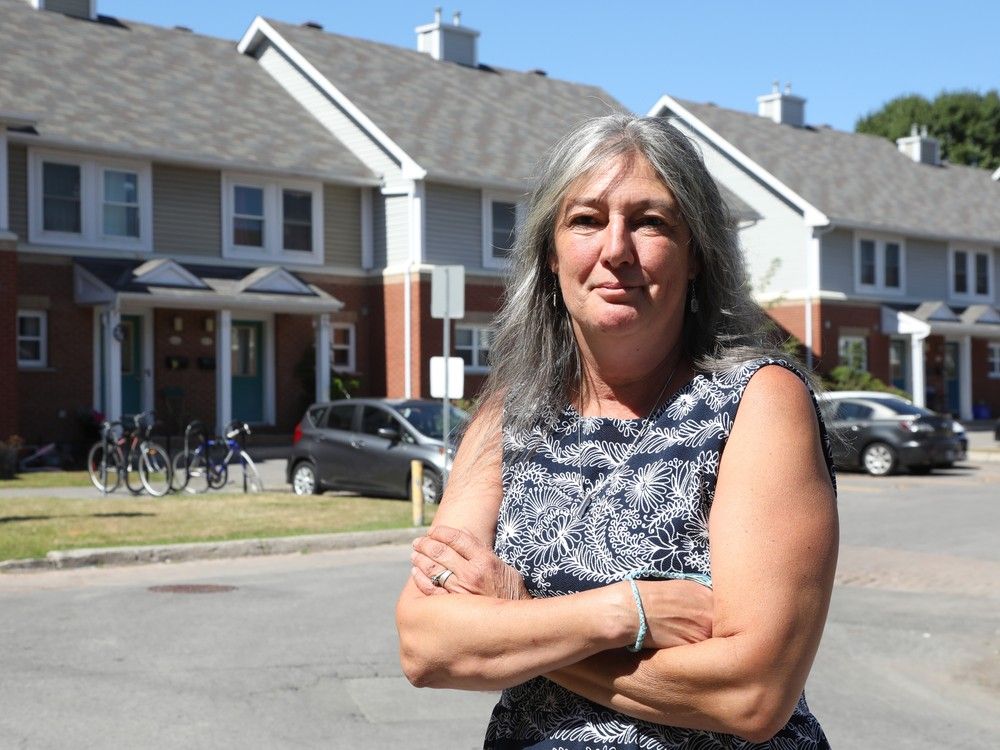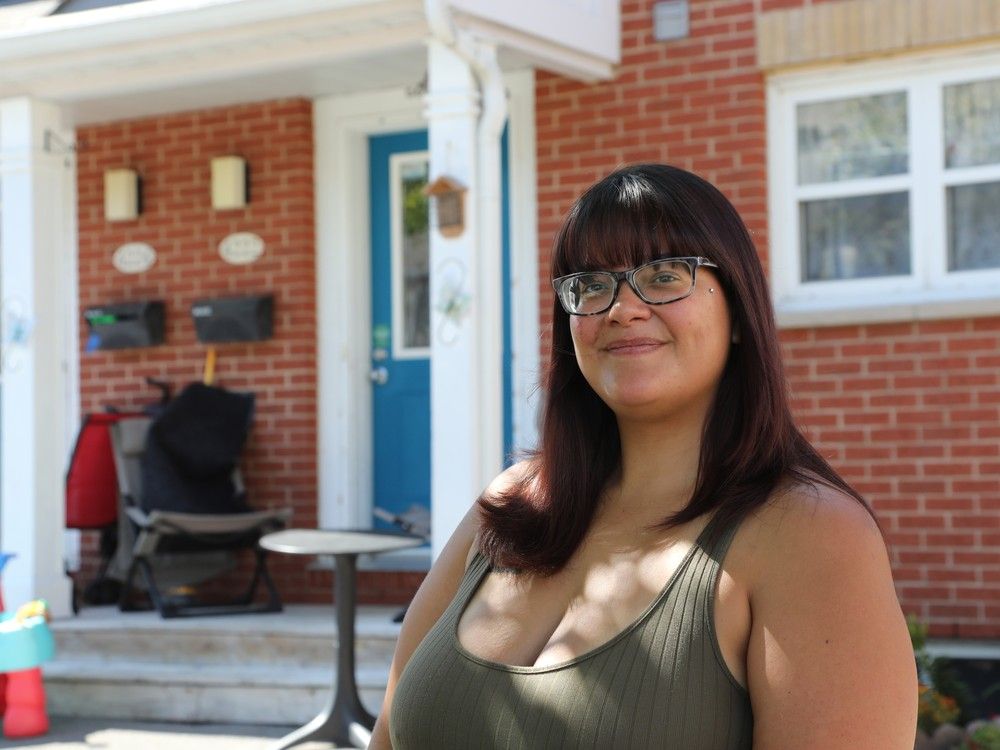Tamika Pipunic lives in the 63-unit neighbourhood of Carver Place with her husband, three children and two pet cats.
She said it was the only available affordable option for her family’s needs when she was searching for a home five years ago. Before this spring, Pipunic and her family relied on portable air conditioners to keep their home cool during the summer.
The central air system recently installed in her home has been a game-changer, she said.
“When I heard that they were actually installing it, I was very happy with that,” she said. “I just gave my (portable air conditioner) away to my mom.”
On a bright and sunny Aug. 14 afternoon, the visitor’s parking spot in front of Pipunic’s home was taken up by a construction company’s car and a large, blue dumpster. The neighbourhood of rent-geared-to-income townhomes was quiet, other than the occasional sound of construction work and murmur from workers circulating the area.
“Everybody’s so nice, everybody’s doing their own thing,” Pipunic said. “It’s just very peaceful here.”
The still, secluded neighbourhood is the site for a retrofitting pilot project.
Pilot project for energy-efficient retrofits
Over the last year-and-a-half, all 63 units of Carver Place have received or are in the process of receiving new insulation, heat pumps, energy-recovery ventilation systems and extensive air sealing.
On Aug. 14, workers were finishing the installation of new insulation in Pipunic’s home.
“The workers are coming in and out,” she said, “but their job is very quick.”
The goal of the project, according to organizers, is to reduce the neighbourhood’s carbon emissions, lower energy costs and make the homes more comfortable for residents. Retrofits in the neighbourhood are expected to be completed by September.
Researchers said the pilot project is a step forward for climate-resilient builds in Ottawa and Canada — specific to affordable housing. For affected residents, the upgrades provide luxuries like heating in the winter and air conditioning in the summer — welcome benefits to some in the neighbourhood.
Pipunic recalled what it was like for years before she had central air conditioning.
“Before, I was coming home and really drained out, then all of the kids were like, ‘Mom, we’re so hot at home,’ and I was already putting (the portable air conditioner) at the lowest setting,” she said. “Now we come home and we’re just like, ‘Ah, nice.’”
Across the street from Pipunic’s home, Christopher Ardovini’s house has green vines and leaves draped across his front awning.
He has lived in Carver Place for about five years. He stays with his sister and her two children. Ardovini says the home has had central air installed for about a year and a half.
“We needed it,” he said. “It’s easy with the thermostat, now, that we can use an app and just pop it on when we need it.”
Environmental benefits
The project is a collaboration between
Ottawa-based non-profit EnviroCentre
and the
Multifaith Housing Initiative
, the properties’ manager and a not-for-profit whose goal is to build affordable housing.
Carleton University researchers are also involved, and will continue to monitor 10 of the project-participating houses for 18 months to measure the environmental impacts of the retrofits.
Data analysis will begin in the fall to assess a full summer season’s worth of cooling, according to project manager Christopher Baldwin with Carleton’s Centre for Advanced Building Envelope Research involved with the Carver Place retrofit.
“One of the main things we’re looking at is reduction in total energy consumption and greenhouse gas emissions,” he said. “We are anticipating a 60 per cent or so reduction in greenhouse gas from the community.”
The Canada Green Building Council
says
residential, commercial and institutional buildings contribute to 18 per cent of Canada’s greenhouse gas emissions, a number that’s closer to 30 per cent when building materials and construction are taken into account. The building sector is Canada’s third-highest carbon emitter.

In 2024, Natural Resources Canada (NRCan) called for an increase in scale and pacing for retrofitting buildings across the country.
According to NRCan, EnviroCentre
received
more than $2 million from their programs for the Carver Place project. It cost $27,000 to retrofit one Carver Place home, according to Melanie Johnston, the director of energy programs with EnviroCentre, which they paid with grants and funding.
The 63 units’ previous gas-run furnaces were nearing the end of their lifespan a couple of years ago, creating a window to install heat pumps instead, she added.
“We had the opportunity here to really do some drastic reductions in greenhouse gases,” she said. “The full benefit was that these units, which did not have cooling previously, would have cooling in the summer.”
Heat pumps
move heat from outside and transfer it indoors in heating mode, while moving heat from inside to outside in cooling mode. They are more energy-efficient for moving heat instead of generating it and burning gas like a gas-run furnace.
Part of the benefit for retrofitting an affordable housing neighbourhood is that retrofits can “save lives,” according to Sarah Sharma, a political science professor at the University of Ottawa who studies how power and politics shape environmental policies.
“Low-income communities are so underserved in terms of being supported to weather and climate changes and natural hazards,” she said. “This could improve people’s quality of living.”
Ala’a Shadid, the executive director of Multifath Housing Initiative, said the project shaves money off of tenants’ monthly bills, as well as “significantly improves (the) tenants’ regular lives” with the “hot summers we have here in Ottawa.”
This
summer has been the city’s driest since 2012
.
A step forward for affordable, energy-efficient houses in Ottawa
To meet Ottawa’s goal of reducing greenhouse gas emissions to zero by 2050, about 327,000 of existing homes must undergo a deep energy efficiency retrofit by 2040, according to the city.
EnviroCentre has about 1,000 units currently in the project planning stage for retrofits, Johnston says. Part of the goal with Carver Place was to set a standard for other projects across the city.
“If an affordable housing provider that’s providing housing for low-income folks strapped for cash can do it, then anybody in Ottawa can do a deep energy retrofit,” she said.
Sharma said the key is for more climate-related financing to be allocated for “projects like this.”
“We live in a time of very big changes, and we need to be able to access climate financing to meet these challenges we are facing,” she said. “That’s just one piece of the puzzle.”
In addition to retrofitting existing buildings, experts say that another part of decarbonizing Canada’s buildings will be to construct the with sustainability in mind. For Nicholas Rivers, a University of Ottawa public and international affairs professor who studies the economic evaluation of environmental policies, part of the solution is looking towards new buildings.
“We’re doing these retrofits which are fixing our mistakes from earlier,” he said. “It’s a lot easier for us to build houses right the first time.”
But in the quiet neighbourhood of Carver Place, Pipunic says the retrofitting project is “good right now.”
“I’m enjoying every upgrade.”
Related
- Modern living: The affordable housing conundrum
- Program in Old Ottawa South offering way forward on retrofits in older homes



